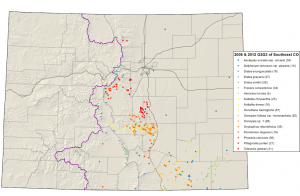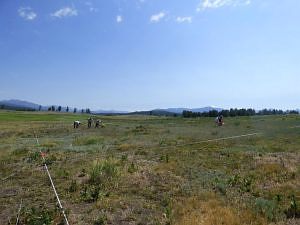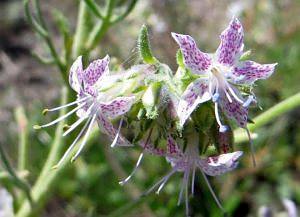Botanists and members of the Colorado Rare Plant Technical Committee (RPTC) were among the group of nearly 60 people gathered at Colorado College in Colorado Springs, CO, to attend the 14th Annual Colorado Rare Plant Symposium. The symposium is held each fall in conjunction with the Colorado Native Plant Society’s (CoNPS) annual meeting, and is hosted by the Colorado Natural Heritage Program (CNHP) and Denver Botanic Gardens (DBG).
Attendees included professional and amateur botanists with a common interest in Colorado rare plants and their conservation. This year Jill Handwerk (CNHP) presented data and photos of rare plant species known from southeast Colorado, along with the critically imperiled (G1) and federally listed plants species of Colorado. New this year was an afternoon review of the U.S. Forest Service (USFS) and Bureau of Land Management (BLM) sensitive species, led by Steve Olson and Carol Dawson, respectively. Additionally, Tim Hogan (CU Herbarium) provided herbarium specimens of the southeast Colorado rare species. The presenters encouraged participants to share their observations about the highlighted species and learn the latest information on Colorado’s rare plant conservation efforts.
Here are some highlights from the 2017 Symposium:
New populations of rare plants reported in 2017 included populations of West Silver bladderpod (Physaria scrotiformis) and Gibbens’ beardtongue (Penstemon gibbensii).
Genetic studies continue to answer taxonomic and management questions for some of our state’s rarest species, including: boatshaped bugseed (Corispermum navicula), Mancos Shale packera (Packera mancosana), Kremmling beardtongue (Penstemon penlandii), North Park phacelia (Phacelia formosula), in addition to Sclerocactus species of western Colorado and eastern Utah.
Habitat was protected by the Colorado Natural Areas Program for Pagosa skyrocket (Ipomopsis polyantha) with the purchase of 88 acres of occupied habitat. Pagosa skyrocket is endemic to the Pagosa Springs area and is federally listed as threatened.
Steve Olson (USFS) provided an update on upcoming changes in how the USFS regional sensitive species lists are developed. The USFS is moving towards Species of Conservation Concern which must focus on ecological conditions, and will be based on NatureServe G and S ranks. Existing Sensitive Species will remain in effect until new management plans are developed for each forest.
Additional afternoon presentations were as follows: Raquel Wertsbaugh with the Colorado Natural Areas Program (CNAP) discussed the recent incorporation of rare plants into the State Wildlife Action Plan and the implications for land management and conservation. Jessica Smith (CNAP) discussed the implementation of monitoring for Pagosa Skyrocket at the newly acquired state owned property. Susan Panjabi (CNHP) gave a brief presentation regarding recently developed Best Management Practices for Roadside Rare Plants, and an overview of the online Colorado Rare Plant Guide. Moderator Jennifer Neale (DBG) concluded the symposium with a discussion of how we, as a group, can share our conservation successes with a wider audience.
For more information:
All of the information from this meeting as well as previous symposia is available online at the Colorado State University, Colorado Natural Heritage Program (CNHP) website: www.cnhp.colostate.edu.
The Rare Plant Symposium is open to anyone with an interest in the rare plants of Colorado. For more information contact Jill Handwerk at jill.handwerk@colostate.edu or Jennifer Neale at nealejr@botanicgardens.org and check the CoNPS website (www.conps.org) for details as they become available about next year’s symposium.
 |
| Location of SE Colorado G2G3 plant species. |
 |
| Survey site for Pagosa Skyrocket. |
 |
| Pagosa Skyrocket. |




